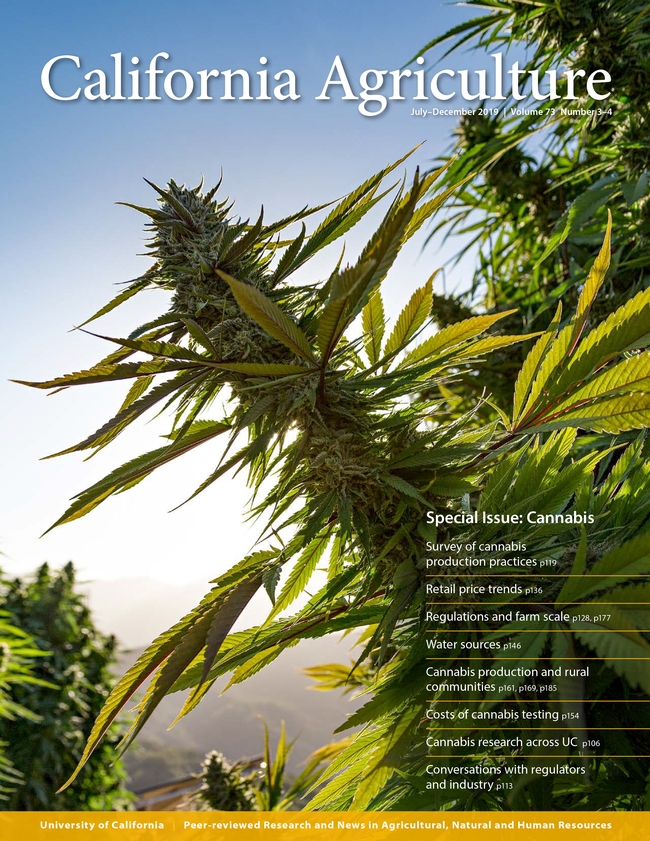
Posts Tagged: California Agriculture
Farming Tips for Enduring Historic Drought
It has been heart breaking to seeing wheat and alfalfa fields dry up the last few weeks. The recent hot temperatures caused many fields to wither, while placing greater irrigation needs on the few crops being irrigated with well water. It's the driest year I have experienced in my...
In memoriam: Burt Hoyle
Burton John Hoyle passed away in McKinleyville on Nov. 9, 2020, just weeks from reaching his 101st birthday. Burton (Burt) was born in Saranac Lake, NY, in 1919. He grew up in the Jamestown, New York, area. He graduated from high school in 1938 and spent several years pursuing odd jobs...
Intermountain UCCE Research Update
Good afternoon Growers! Just like you, the Intermountain UCCE researchers have had a busy year, despite the turmoil surrounding us. Now that field work is done, it's time to take a look at the results. In the attached Intermountain UCCE Research Update you'll find articles on alfalfa, grain and...
Intermountain UCCE Research Update

Spring Wheat at IREC
UC ANR's California Agriculture journal presents a special issue on cannabis
In 1953, amid reports that cannabis was growing around San Mateo County, the local sheriff's office and the UC Agricultural Extension Service in Half Moon Bay issued a booklet entitled Identify and Report Marihuana. The booklet envisioned “total eradication” of cannabis. The authors couldn't have imagined that, in 2017, the San Mateo County Board of Supervisors would pass an ordinance allowing greenhouse cultivation of cannabis in the county's unincorporated areas.
A lot can happen in 60-plus years — such as voter approval of Proposition 64, the 2016 ballot measure that altered California law to allow the recreational use of cannabis by adults.

That said, federal restrictions still inhibit many aspects of research (see page 104 for more detail). Cannabis research is also inhibited by funding constraints. The $10 million in annual research funding that Proposition 64 allocated to California universities has not begun to flow, and the Bureau of Cannabis Control — the entity responsible for disbursing the money — reports that it is still establishing guidelines for doing so.
Despite these obstacles, UC cannabis research in the legalization era is well underway, as attested by this special issue of California Agriculture. The research articles presented here fall into three broad categories — research into cannabis production, into the economics of the cannabis industry in California and into the social and community impacts of cannabis. The three articles focused on cannabis production include the results of the first known survey of California cannabis growers' production practices, by Wilson et al. (page 119). In the article “Characteristics of farms applying for cannabis cultivation permits” (page 128), Schwab et al. combine data on cannabis farms with information about applications for cultivation permits, establishing that, of farms within the dataset, those seeking permits tended to be larger and to have expanded faster than other farms. And on page 146, Dillis et al. analyze data submitted to the regional water quality control board to characterize the water sources used by cannabis cultivators in the Emerald Triangle region (Humboldt, Mendocino and Trinity counties).
Articles focused on the economics of the cannabis industry include a study by Goldstein et al. (page 136) analyzing online retail prices for cannabis flower and cannabis-oil cartridges as changes in regulation and taxation have taken effect in recent years. Valdes-Donoso et al. (page 154) analyze data from sources including California's cannabis testing laboratories to estimate the cost per pound of testing under the state's regulatory framework.
Four articles explore the social and community impacts of cannabis production. On page 161, Valachovic et al. report the results of a survey of timberland and rangeland owners in Humboldt County, who shared their experiences with the rapid expansion of cannabis production in their region and its attendant social, economic and environmental challenges. LaChance (page 169) interviewed noncannabis farmers, ranchers and others across Humboldt, Mendocino and Sonoma counties, eliciting their views on issues such as increased land prices amid cannabis legalization. For the article “Growers say cannabis legalization excludes small growers, supports illicit markets, undermines local economies” (page 177), Bodwitch et al. surveyed cannabis growers to gain insight into their experiences with the state's system for regulation of commercial cultivation. Finally, on page 185, Polson and Petersen-Rockney employed ethnographic methods to study cultivation regulations in Siskiyou County and their effects on the county's Hmong-American community. The special issue was conceived by Van Butsic and Ted Grantham — UC Cooperative Extension (UCCE) specialists based at UC Berkeley — and Yana Valachovic — a UCCE forest advisor and director for Humboldt and Del Norte counties. Butsic, Grantham and Valachovic developed the issue in collaboration with Daniel Sumner, a UC Davis professor of agricultural economics and director of the UC ANR Agricultural Issues Center, and with the staff of California Agriculture.
See you at IREC on July 26!
